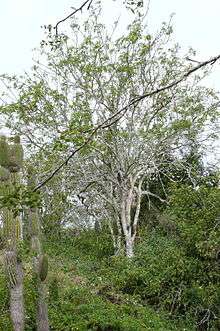Bursera graveolens
Bursera graveolens, known in Spanish as palo santo ("holy stick"), is a wild tree native from the Yucatán Peninsula to Peru and Venezuela[1].
| Bursera graveolens | |
|---|---|
 | |
| Scientific classification | |
| Kingdom: | Plantae |
| Clade: | Tracheophytes |
| Clade: | Angiosperms |
| Clade: | Eudicots |
| Clade: | Rosids |
| Order: | Sapindales |
| Family: | Burseraceae |
| Genus: | Bursera |
| Species: | B. graveolens |
| Binomial name | |
| Bursera graveolens (Kunth) Triana & Planch. | |
| Synonyms | |
|
List
| |
Bursera graveolens is found in the seasonally dry tropical forests of Mexico, Venezuela, Costa Rica, El Salvador, Guatemala, Honduras, Colombia, Ecuador, Peru[2] and on the Galápagos Islands.[3] The tree belongs to the same family (Burseraceae) as frankincense and myrrh. It is widely used in ritual purification and as folk medicine for stomach ache, as a sudorific, and as liniment for rheumatism.[1] Aged heartwood is rich in terpenes such as limonene and α-terpineol.
Conservation
The government of Peru has listed Bursera graveolens as "In Critical Danger" (En Peligro Critico (CR)) under Decree 043-2006-AG, banning the cutting of live trees and allowing only for the collection of naturally fallen or dead trees.[4]
Illegal logging is a regular occurrence in northwestern Peru due to high demand.[5][6] In 2010, the International Union for Conservation of Nature (IUCN) stated Bursera graveolens conservation status as "stable"[7][8].
Uses
Modern uses
Palo santo is used for crafting objects and to produce burning sticks and incense. Production of essential oil is attracting most of the modern interest. Chemical composition, as reflected by aroma, is variable. The essential oil of palo santo is generally termed "Palo Santo Oil", and has received the Chemical Abstract Services number, 959130-05-3. When used as an ingredient in cosmetics the INCI name "Bursera graveolens wood oil" should be listed.
Ethnobotanical uses
The use of palo santo from B. graveolens is traditional in South America, especially in Ecuador. According to the local customs, it is used against the "mala energía" (bad energy) ("Palo santo para limpiar tu casa de la mala energia, palo santo para la buena suerte" or "Palo santo to clean your house of bad energy, palo santo for good luck"), which may sometimes refer to clinical disease. Its use reportedly dates back to the Inca era.[9] Palo santo is common today as a type of incense, which gives off an aroma reminiscent of baked apples or burnt sugar.
Palo santo oil was used during the time of the Incas for its reputed spiritual purifying properties. Today, palo santo oil may be applied to the body (such as at the base of the skull or on the spine) to increase relaxation,[9] similar to aromatherapy.
Palo santo may be burned, similar to incense, by lighting shavings of palo santo wood. In Peru, a shaman, or medicine man, reportedly lights palo santo sticks and the rising smoke will enter the "energy field" of ritual participants to "clear misfortune, negative thoughtprints, and 'evil spirits'".[10] Peruvians harvest fallen branches and twigs of the B. graveolens tree, a practice that is regulated by the government of Peru, so trees are not cut for wood harvesting.[11] The charcoal of palo santo sticks can also be used for ritual smudging. Yoga studios and witchcraft practitioners utilize the substance.[12]
References
- Nakanishi, Tsutomu; Yuka INATOMI; Hiroko MURATA; Kaori SHIGETA; Naoki IIDA; Akira INADA; Jin MURATA; Miguel Angel Perez FARRERA; Munekazu IINUMA; Toshiyuki TANAKA; Shogo TAJIMA; Naoto OKU (February 2005). "A new and known cytotoxic aryltetralin-type lignans from stems of Bursera graveolens". Chemical and Pharmaceutical Bulletin. 53 (2): 229–31. doi:10.1248/cpb.53.229. PMID 15684524. Retrieved 2011-10-31.
- "Bursera graveolens". Germplasm Resources Information Network (GRIN). Agricultural Research Service (ARS), United States Department of Agriculture (USDA). Retrieved 1 November 2011.
- "Ecuador Palo Santo Project". www.floracopeia.com. Retrieved 2019-08-15.
- "Aprueban categorización de especies amenazadas de flora silvestre" (in Spanish). 2006-07-13. Retrieved 2019-10-27.
- Zapata, Ralph (2019-10-11). "Piura: autoridades decomisan 1,5 toneladas de palo santo de procedencia ilegal". El Comercio (Peru) (in Spanish). Retrieved 2019-10-27.
- "Chiclayo: decomisan más de tres toneladas de palo santo trasladados de manera ilegal". Radio Programas del Perú (in Spanish). 2018-03-01. Retrieved 2019-10-27.
- Mexico), Alejandra Fuentes (National Autonomous University of; Salas, Esteban Martínez; Samain, Marie-Stéphanie (2019-03-01). "IUCN Red List of Threatened Species: Bursera graveolens". IUCN Red List of Threatened Species. Retrieved 2020-08-14.
- Martin, Crystal (2019-12-16). "Is Palo Santo Endangered?". The New York Times. ISSN 0362-4331. Retrieved 2020-08-14.
- Gibson, Ruby (2008). My Body, My Earth: The Practice of Somatic Archaeology. iUniverse. p. 88. ISBN 9780595488230.
- Lemdo, Margaret Ann (2011). All About Smudging. Llewellyn Worldwide. pp. No page. ISBN 9780738733142.
- Farmer, Steven D. (2009). Earth Magic: Ancient Shamanic Wisdom for Healing Yourself, Others, and the Planet. Hay House Inc. p. 123. ISBN 9781401920050.
- Bosker, Bianca. (March 2020). "Why Witchcraft Is on the Rise". The Atlantic magazine website Retrieved 14 February 2020.
External links
